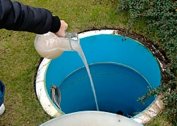Among the methods of organizing suburban sewage, three main ones can be distinguished: the installation of a septic tank, a cesspool without a bottom, or the installation of a sealed container. Despite significant structural differences between these structures, they share a common feature - the need for periodic pumping with the help of a cesspool machine.
Neglect of this requirement will lead to a threat to the health of people living and the environment, as well as poison the life of the spreading stench. Attracted by a strong smell, insects will create new difficulties and make living impossible.
What is a cesspool
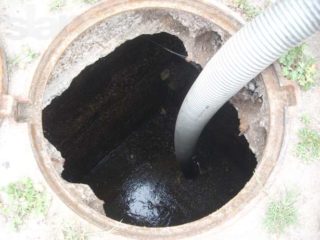 The cesspool is an elementary structure for wastewater disposal. However, with its design, it is necessary to adhere to certain requirements. Material for construction can serve:
The cesspool is an elementary structure for wastewater disposal. However, with its design, it is necessary to adhere to certain requirements. Material for construction can serve:
- plastic;
- brick;
- metal;
- reinforced concrete (monolithic or prefabricated rings).
It is preliminarily determined whether the container will be sealed or leakage of liquid into the soil is permissible. At high groundwater levels, the construction of an impenetrable structure is recommended. Under favorable conditions, it is possible to build a filter well, which is an absorbing hole with a layer of sand and gravel at the bottom. Due to the absorption of liquid into the soil, the call of the dump truck is less frequent.
The best solution is to use a septic tank, since it usually consists of two or three compartments where mechanical and biological wastewater treatment takes place. Despite the high efficiency of such plants, they also have a tendency to siltation and require periodic cleaning.
How often do you need to pump out
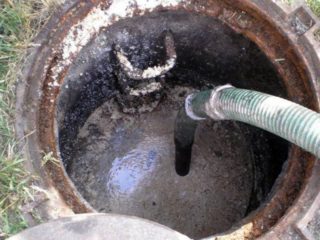 The frequency of cleaning the cesspool depends on the following parameters:
The frequency of cleaning the cesspool depends on the following parameters:
- daily volume of effluents;
- tank dimensions;
- the percentage of heavy particles in the effluent.
When calculating, it is necessary to take into account to which class the solids entering the pit belong. Distinguish:
- Organic (degradable) fractions. These include cellulose, toilet paper, feces. The decomposition of such substances will require a lot of time.
- Residues that are not biodegradable (plastic, animal litter and other materials). Such fractions quickly fill the pit volume and require elimination for the normal functioning of the structure.
It is important to minimize the amount of biodegradable and non-degradable particles in wastewater. In this case, filling the filter well or septic tank will not occur so quickly. With regard to a sealed container, this rule is of little use, since the mass entering it does not leak anywhere.
The next factor determining the frequency of pumping is the amount of water consumption by residents. This indicator depends on the number of people living in the house and their habits of spending water. In families where it is customary to take a shower daily, filling the pit will occur many times faster. Household age also affects the amount of water consumed. It has been found that older people send significantly less waste to the pit.
If a filter well is chosen as a wastewater collector, its ability to absorb moisture will directly depend on the amount of heavy fractions deposited on the bottom. With a large accumulation of biomass in the filtering part of the structure, the soil loses its ability to absorb daily incoming fluid.
The costs of biomass removal both in time and in material means are high. When pumping, the sediment located at the bottom of the pit should be removed.For this, it is necessary to ensure free access of the pump to this area. After complete removal of water, the biomass decomposes in a few days.
If the used container is tight, then its filling and, accordingly, the pumping frequency will directly depend on the amount of water consumed over a period of time. For example, if we take the norm of daily water consumption of 200 liters per person, the number of people living is 5, and the capacity of the cesspool is 3.5 cubic meters. m., it is easy to calculate that it will be necessary to pump out the pit after 3 days. With a more moderate use of water, you can delay the time of the next call of the cesspool machine.
In the case of filter wells and septic tanks, an accurate calculation of the pumping frequency is not possible. This indicator depends on the absorption capacity of the soil itself, the clogging of the day with a muddy sediment. In any case, the need to clean such structures arises much less frequently than when operating a sealed container.
Pumping down with a cesspool machine
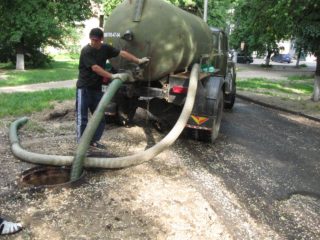 Removing and disposing of household waste of a liquid consistency is the task of a cesspool machine. There are several types of this special equipment:
Removing and disposing of household waste of a liquid consistency is the task of a cesspool machine. There are several types of this special equipment:
- vacuum;
- mixed;
- sludge pump.
The machine is equipped with special tools for the implementation of the specified functions:
- sealed tank with a capacity of 5-7 cubic meters. m .;
- a pump;
- hose for pumping drains.
Typically, the volume of the cesspool does not exceed 5 cubic meters. m., which allows you to clean it completely in one go.
There are several ways to clean the pit, depending on the equipment used. Exist:
- vacuum cleaning - is carried out in the presence of a vacuum pump;
- hydrodynamic pumping - the work is carried out in three stages: removal of effluents, filling the tank with water and cleaning the walls and re-pumping;
- The use of a sludge pump is the most cost-effective way to remove wastewater, bringing good results.
The use of cesspool machines allows you to clean the cesspool quickly and without the risk of contamination. When choosing this method of emptying the tank with drains, you should provide access to the pit and take into account the length of the suction hose (it is 3-4 m). In the case of a greater depth of containers, you must take care of additional ways to clean its bottom.
With long-term operation of the structure, there is a need to soften the dense sediment on its walls. For these purposes, use biological and chemical agents. In this case, it is necessary to fill in special preparations a few days before the arrival of the car and not use the sewage system during this period. Such a measure is used to separate effluents into liquid and solid fractions.
Pump down
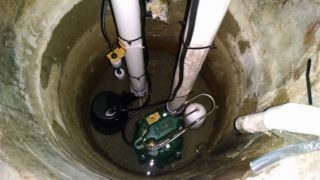 Using a fecal pump will save you from the additional cost of pumping a cesspool. The complexity of this cleaning method lies in the choice of the place of discharge of sewage. The process of disposal of household liquid waste is not difficult. For these purposes, you can even use an ordinary water pump, after protecting the inlet pipe with a special grill or grinder.
Using a fecal pump will save you from the additional cost of pumping a cesspool. The complexity of this cleaning method lies in the choice of the place of discharge of sewage. The process of disposal of household liquid waste is not difficult. For these purposes, you can even use an ordinary water pump, after protecting the inlet pipe with a special grill or grinder.
All high-quality fecal pumps are equipped with a grinding device, which allows them to function well in an aggressive environment.
If it is possible to dispose of wastewater at your site, you can set up pumping by fecal suction when sewage reaches a certain level. Living in a densely populated village or city complicates the process of independent disposal of effluents or makes it impossible.
When working independently with the pump, you should provide yourself with protective clothing and a respiratory mask. Pumped sewage can be aggressive chemicals, and methane generated by the decomposition of biological residues poses a threat to human health.The use of biological products for the decomposition of waste makes it possible to thin out solid particles and facilitate pumping. Chemical cleaning agents also contribute to the decomposition of organics and the elimination of accumulations of particulate matter.
The choice of the method of pumping out the cesspool remains with the owner of the private house. With periodic and irregular residence on a summer cottage, you can refuse the services of scavengers and independently clean your tank from wastewater manually or using a pump. The main difficulty in this case is the need to dispose of waste water. Such an opportunity does not always exist, and therefore there is a great risk of falling under penalties and incur administrative liability.
Using a cesspool machine eliminates the above concerns of the homeowner. Its main task in this case is to provide free access to the pit. Financial costs will more than pay for the lack of worries about draining drains, the need to inhale unpleasant odors and get dirty.
As a rule, a family of 4-5 people permanently residing in the house uses the services of sewage service workers at least once every 1.5 weeks. Therefore, it is necessary in advance to include in the family budget an item of expenses for the removal of sewage. This option, despite the significant costs, is best for houses in which people live permanently.

